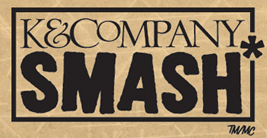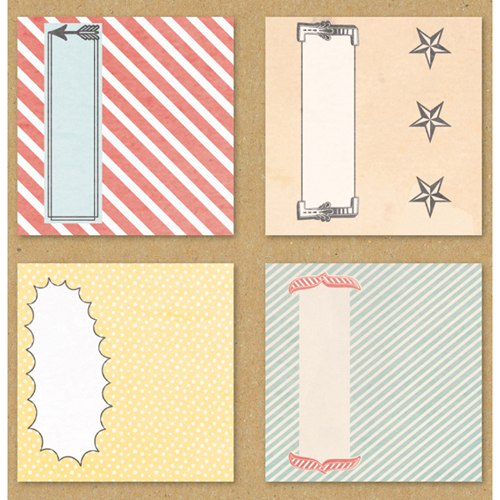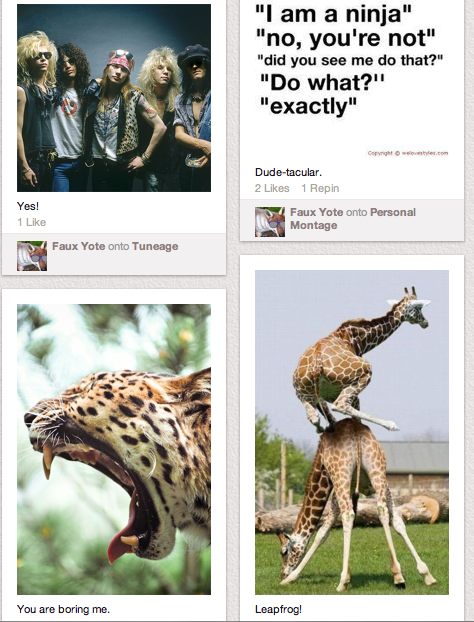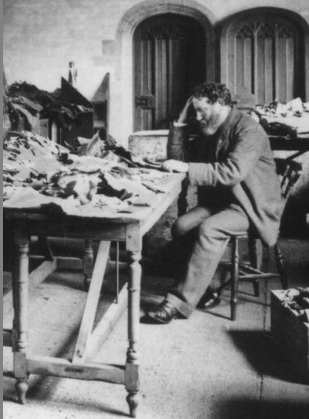Paper Doll Organizing Carnival — Paper’s Imperfect Past, Present and Future
Once again, we’re pausing to look at some of the quirky and delightful, thought-provoking and useful things that have popped up while we’ve been focusing elsewhere.
LESS PAPER VS. PAPERLESS

The title of I Heart Tech‘s Paperless for Lawyers — A 12 Step Plan only incidentally creates a parallel between a smattering of advice and the well-known steps of a recovery program. After all, it’s not like the blogger, Adriana Linares, starts by asking the reader to admit he or she is powerless over paper.
Nonetheless, Paper Doll knows how addictive paper can be. It’s tangible and immediate, and whether loose or bound, paper is comforting. While it can, conceivably, burn or be tossed away, there’s a safety in its permanence that many of us, even those who embrace technology, prefer to the idea of going paperless.
While I Heart Tech’s advice is designed for attorneys and legal practices, many of the general concepts are applicable to all of us. If we want to reduce paper (and let’s face it — we DO want to reduce it; we just don’t want to wipe it out entirely), we need to start with a plan (#1) for reaching our goals. Moreover, getting a scanner (#4), converting more paper to digital formats (#6), keeping digital documents from being printed by “printing to PDF” (#8) and replacing traditional faxing with e-faxing (#7) are all smart tactics.
However, as a professional organizer, I’m dubious that some of these tips are practical, even for attorneys. I imagine that her hyperbolic advice (#3) to squirrel away printing supplies and force staffers who use them to be visibly accountable each time they need something, would destroy more, in terms of the value of productivity, than it would gain in the value of printing supply costs. I’m even more skeptical of scanning all incoming physical mail (#10), which I believe would be just as unproductive for a 100-person law firm as a three-person family.
If you’re thinking of going digital with your files, remember that your time is valuable, and focus on scanning documents which you have a reasonable likelihood of referencing later on. A widely-noted statistic in professional organizing is that upwards of 80% of documents filed are never looked at again; do you really want to spend your precious hours scanning every darn thing? It’s a simple fact that sometimes, having a paper element to your filing system is just more efficient.
Finally, while I empathize with Linares’ frustration over documents that are printed solely so that they can be signed and then scanned and emailed, the subject of electronic signatures (#11) is likely to make the average user somewhat queasy. What does it mean when something that is inarguably your signature doesn’t require you to create it? Be assured, we’ll be talking more about electronic signatures in an upcoming post.
TAB, AND TAB ALIKE
Right after last week’s post on tabs went to press, two other free-standing tab options, one practical and one mainly aesthetic, came to my attention.

On the practical side, paper powerhouse Smead has Add-A-Tab, manila card stock filing tabs with adhesive strips on the front, enabling users to affix them to the back edges of tab-less folders, binder dividers and file pockets.

The neutral/beige Add-A-Tabs come in 32-packs with four assorted color-coding top stripes (in red, blue, yellow and green), and are made of 10% recycled content and 10% post-consumer material.

On the pretty side of things, mere moments after I’d put last week’s post to bed, K & Company’s Paper SMASH Tabs presented themselves. These colorful, decorative tabs, printed on thick card stock, come 16 to a package and are themed to the SMASH line of scrapbooking products.

Although Paper Doll is not a scrapbooker, I have it on authority from numerous sources that these are popular doohickeys, equally suited for use with Smash and other scrapbooking products, journals and various creative endeavors.
DUDE, THAT’S AN AWESOME PIN!
Speaking of after-deadline finds, many weeks after I shared a bulletin board full of guy-themed alternatives to Pinterest, including Gentlemint, Manteresting and DartItUp, a new contender pinned itself to my sleeve.

Dudepins, with the motto “Man up, Sign up, Pin up,” is in beta, currently accessible by invitation only, after which one may sign up via Twitter, Facebook or email. Pinned topics (like alcohol, implements of destruction, cars, and sports) may tend more towards guy-ish stereotypes than the classier Gentlemint, but there’s no doubt there’s an ample bacon- and scotch-loving audience for such pins. And then there this:

It’s not yet clear how much effort has gone into the branding of these male-themed pinboard sites, but I think it’s safe to say that Dudepins is leaning a bit more towards attracting a younger, more casual dude than Gentlemint seeks.
Instead of the mints, workbenches and dartboards of its pinboard brethren, Dudepins’ users create montages (oooh, classy) to categorize and store pins, which are added either via the “Pin up” button (an installed browser bookmarklet), uploading from one’s hard drive or navigating to a site from Dudepins.
Generally, newcomer Dudepins is a masculine copycat of Pinterest with less interest in distancing itself from the mother ship than the other guy-boards. I found the main difference only by watching the instructional video; the voice-over accent made it clear to my native Buffalonian ears: Dudepins is Canadian! And longtime readers know that my adoration of North-of-the-Borderisms extend even beyond my Professional Organizers in Canada colleagues and the world’s best candy bar…so give Dudepins a look-see.


THE GENIZAH PROJECT
Finally, I was intrigued by an article in Washington Jewish Week about an art installation (through this Saturday) at Washington, DC’s Artomatic. Artist Rachel Farbiarz sent out a call that, to some, might have the poignancy of Emma Lazarus’ poem at the base of the Statue of Liberty, “…Give me your tired, your poor, your huddled masses yearning to breath free…” Farbiarz’s request:
I am offering a means of disposing the scraps that you have carried throughout life and no longer want to carry. They can go if there is a place for them: I’ll be your place and we will put them to rest as art.
Send me your: holiday greetings, letters from old boyfriends, birth announcements, thank you cards, notes passed in grade school. Send me your: letters not sent, save-the-date reminders, old calendars and daily planners. Send me your: lists of things-to-do not-done, ancient valentines, finger-paintings from long-grown toddlers, postcards from around the world. Send me those papers that have followed you everywhere. Send me those things that were once disposable, but through the passage of time have become not-so.
Farbiarz created The Genizah Project. For those unfamiliar, a Genizah was historically a repository for damaged Jewish holy books and documents set to be ritually buried in a cemetery. The Genizah provided a way for communities to dispose of sacred materials in a way that honored them and showed respect.
However, in certain communities, no ritual burial ever took place. Indeed, in the case of the Cairo Genizah, for over 1000 years, a community collected not only crumbling Torahs and prayer books, but a vast stockpile of both personal papers and public documents.

To reflect an understanding of the role of such paper collections, Farbiarz recently ran a workshop at Washington’s landmark Sixth & I Historic Synogogue. As the Washington Jewish Times described it:
…the workshop was part support group, with participants carefully admitting that they are “savers,” “collectors” and “pack rats.” Farbiarz encouraged them to consider the fallacy that if something has been saved it is somehow important, even sacred.
We all face the issue of attachments to papers every day. We save papers for a myriad reasons. We hold on to papers because we are overwhelmed by the bulk, and don’t know where to start. We hold on because of genuine sentiment, and the affection and warm feelings bought on by old love letters and driving directions to kindergarten orientations.
And we hold on to papers out of fear. Certainly there’s fear that we will be in trouble, legally or financially, if we dispose of important documents, receipts or statements, but at least that fear can be easily overcome with confident assertions from experts.
But there’s another kind of fear that keeps us attached, creating junk drawers and filing cabinets and cedar chests that turn into our own personal Genizahs. This is the fear that we will be forgotten. As the Washington Jewish Times story alludes, mankind has always created or saved some things that serve as landmarks for future travelers to find, as a way to say, “I was here.”
The difference is that just as our homes, our possessions and our waistlines are vastly increased vs. that of prior generations’, the collected paper ephemera and memorabilia of our lives have exponentially increased. There’s less room — in our lives, on our planet — and increasingly more difficulty persuading someone not to treat an expired car registration with the same sacred reverence as a marriage certificate.
Every day, we try to help clients find a way to balance being comfortable with letting go of what isn’t serving their needs (for space, for serenity, for a clear writing surface) with retaining enough tangible proof of their existence to feel just a little bit eternal. For clients, as much as for me when I debate tossing my college ID or love letters that outlasted an eleventh grade romance, it’s always a bit of a struggle.
Farbiaz plans to repeat the The Genizah Project installation in other cities. Her plea for submissions to the DC exhibit ended with:
At Artomatic’s end, the piece will be disassembled and your papers put to rest in a manner befitting their dignity. You will not receive your papers in return.
Oh, if only all we needed in order to be comfortable with letting go of our excess papers were to agree on a manner befitting their dignity.




Follow Me